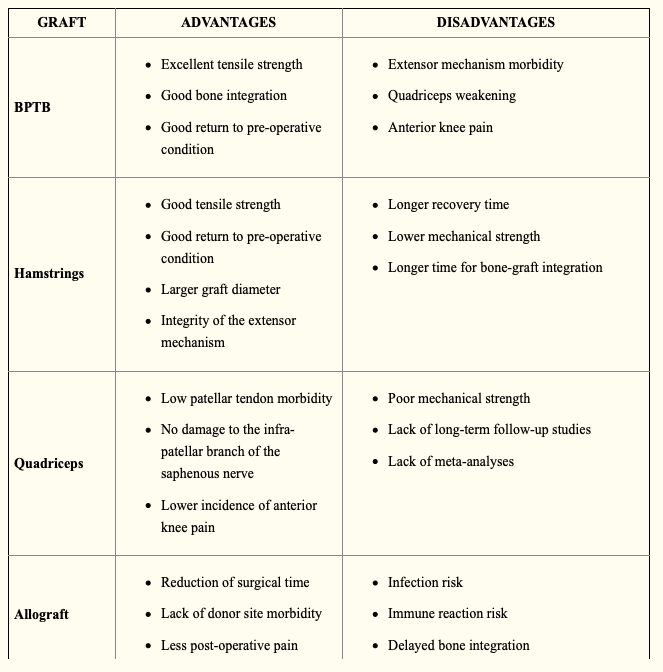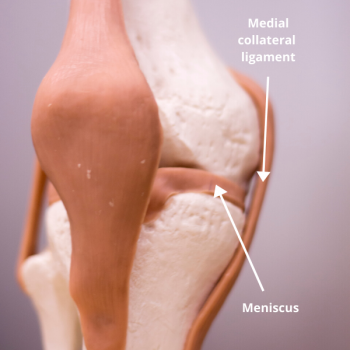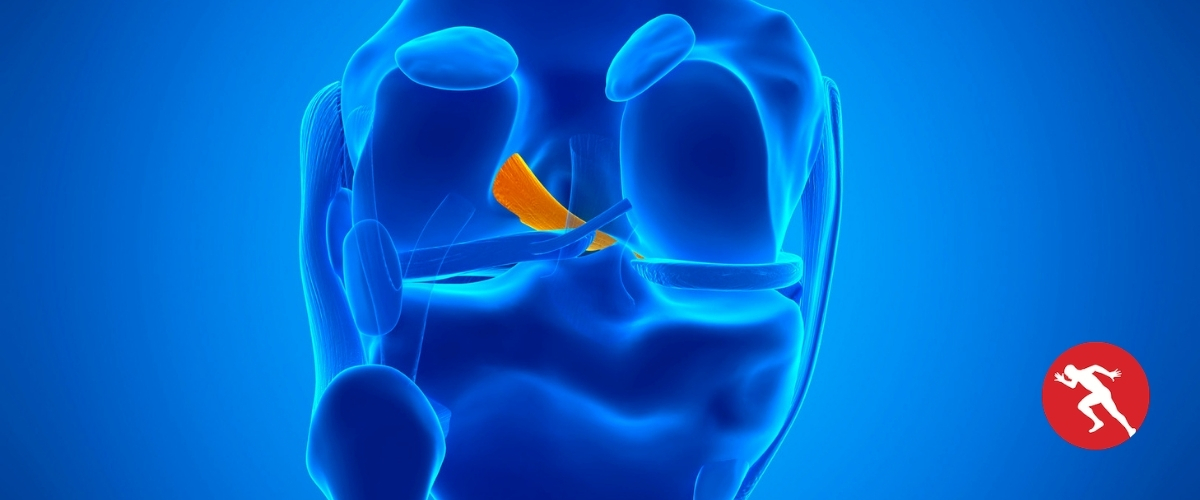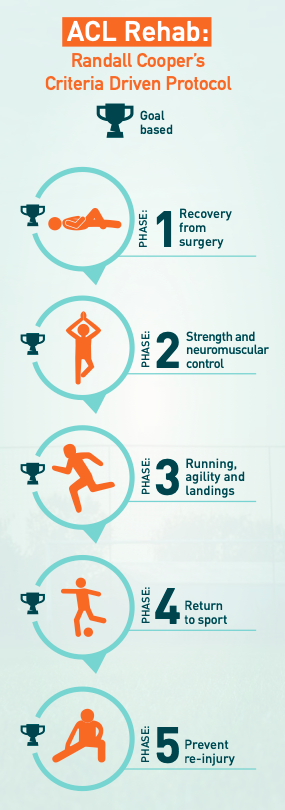Have you had an anterior cruciate ligament (ACL) repair and were wondering how long your ACL injury recovery time would be?
It is the first question I get asked when someone attends for Physio Performance.
It is often thought 9 months is the time to return to sport but it is not as straightforward as that.
The following should make it clearer when you will be back playing sport.
Average Recovery Time
A research study found that 82% of people make a full recovery to return to sport.
The average ACL injury recovery time of this group is between 9-12 months.
However, for some people it could be less than 9 months and for others, more than 12 months.
There are many factors that influence recovery times that we will discuss later.
A study that looked at Professional Italian Footballers, showed an average recovery time of 7.6 months.
American National Football League players returned to play on average 11.5 months after ACL surgery.
The recovery time is dependent upon the sport played i.e. American Football is more physically demanding than soccer.
Another study analysed 234 athletes after ACL surgery and only 18.5% of them returned to sport within 6.5 months of rehabilitation.
A recent example is the return of professional soccer player Alex Oxlade-Chamberland with Liverpool Football Club. He returned to competitive action 1 year after surgery.
This is with having intense rehabilitation with the best Sports Physiotherapists, Strength and Conditioning Coaches, Doctors and facilities.
What these figures show, is that even with intense sports rehabilitation, an ACL injury recovery time is more realistic to be more than 9 months.
5 Factors That Influence Your ACL Injury Recovery Time
- Type of Graft
A torn anterior cruciate ligament needs to be replaced with another part of the body to stabilise the knee.
These types of grafts are used:
- Bone-patella tendon-bone (BPTB)
- Hamstring muscle
- Quadriceps muscle
- Allograft (cadaver graft)
It is mostly chosen by the experience of the surgeon and what they have found to be the most successful.

For example, a bone-patella tendon-bone (BPTB) graft is stronger, however, people report having anterior knee pain during and after their recovery.
Someone who has a hamstring graft will not get anterior knee pain. However, their recovery may be longer.
2. Associated Knee Injuries
Sometimes other structures of the knee get injured in combination with the ACL.
When the knee joint is forced out of position during an ACL injury, it stresses other parts of the knee.
The medial collateral ligament (MCL) on the inside of the knee can get torn.
Depending on the degree of injury, a surgeon may want the MCL to heal first, before considering ACL surgery.
This will add stability back to the knee, in preparation for surgery.
In addition to the MCL being stressed, the knee joint shock absorbers, the meniscus can also get injured.
Depending on the location of the meniscal injury, the surgeon may also repair this during the surgery.

3. Type of Activity/Sport You Will Be Returning To
If your goal is to get back jogging, then 6 months is a realistic target.
However, as previously discussed, if you play a physically demanding sport such as soccer or American football, 9-12 months is the most likely injury recovery time.
4. Motivation
A good sports physio will guide you through the rehabilitation process, from day 1 to getting back playing sport.
Motivation is key to following the process.
There is a fine line between too little and too much motivation.
Rushing back to sport too quickly can increase the risk of rupturing the new graft.
It also often results in picking up other injuries and prolonging the recovery time.
On the other hand, if you are not prepared to work hard on your rehabilitation exercises, the recovery time is always going to be slower.
5. Fear of Re-Injury
Physically you may be ready to return to sport after months of hard work.
However, Physiotherapists sometimes find athletes suffer from fear of re-injury (kinesiophobia).
It is thought to be the most common reason that 18% athletes do not return to sport after surgery.
Goal Based Recovery, Not Time Based Recovery
In the past, ACL injury recovery time was based on a timescale.
The issue with this is that people recover at different rates due to the factors discussed above.
For example, take two people at nine months post ACL surgery.
One of them may be able to run, jump and land safely with no issues.
The other person may be able to run but they struggle to jump and land safely on their operated knee.
This will be a major factor when playing a sport that involves jumping and landing i.e. football and basketball.
A better and more successful method of measuring recovery is to use a criteria or goal based system.
Instead of using a timescale, we use benchmarks to gauge recovery.
Infographic from YLMSportsScience
I personally use the following in-depth ACL Rehabilitation Protocol from the Olympic Park Sports Medicine Centre in Melbourne.
Goals are used to progress through the different phases of recovery.
For example, to progress from Phase 1 to 2, you must be able to:
- Fully straighten your knee
- Have minimal knee swelling
- Have good quadriceps strength
This ensures your knee is safe to move onto the next stage.
Previous protocols would have used a timeframe of 1-2 weeks to progress to phase 2 but people recover at different rates.
Conclusion
The ACL injury recovery time of 9 months is not set in stone.
Returning to sport depends on how quickly and safely you progress through the rehabilitation phases.
5 factors to consider are:
- Type of graft
- Associated knee injuries
- Type of activity/sport you will be turning to
- Motivation
- Fear of re-injury
References
Cerulli, G., Placella, G., Sebastiani, E., Tei, M.M., Speziali, A. and Manfreda, F., 2013. ACL reconstruction: choosing the graft. Joints, 1(1), p.18.
Cooper, R., 2013. ACL Rehabilitation Guide.
Medvecky, M.J. and Nelson, S., 2015. Kinesiophobia and Return to Sports After Anterior Cruciate Ligament Reconstruction. Connecticut medicine, 79(3).
Okoroha, K.R., Fidai, M.S., Tramer, J.S., Elmenini, J., Makhni, E.C., Verma, N.N., Bach, B.R. and Moutzouros, V., 2019. Length of time between anterior cruciate ligament reconstruction and return to sport does not predict need for revision surgery in National Football League players. Arthroscopy: The Journal of Arthroscopic & Related Surgery, 35(1), pp.158-162.
Raoul, T., Klouche, S., Guerrier, B., El-Hariri, B., Herman, S., Gerometta, A., Lefevre, N. and Bohu, Y., 2019. Are athletes able to resume sport at six-month mean follow-up after anterior cruciate ligament reconstruction? Prospective functional and psychological assessment from the French Anterior Cruciate Ligament Study (FAST) cohort. The Knee, 26(1), pp.155-164.
Roi, G.S., Nanni, G. and Tencone, F., 2006. Time to return to professional soccer matches after ACL reconstruction. Sport Sciences for Health, 1(4), pp.142-145.
Queen, R. M. (2017). Infographic: ACL injury reconstruction and recovery.
Zaffagnini, S., Grassi, A., Serra, M. and Marcacci, M., 2015. Return to sport after ACL reconstruction: how, when and why? A narrative review of current evidence. Joints, 3(1), p.25.



